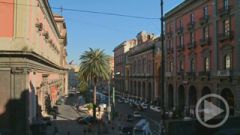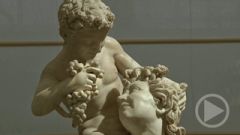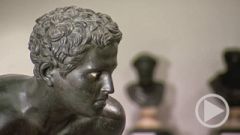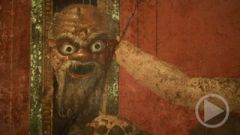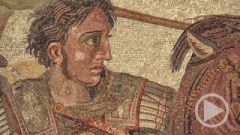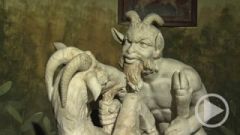Everyday Objects and Glass
Everyday Objects and Glass
Pictures and statues were not the only ways the Roman emperors had themselves glorified – the most successful means of propaganda was the tiniest of all – the coin. With their ingenious pictorial language, coins conveyed the ruler’s self-image and asserted his claim to leadership – particularly in order to legitimize a newly enthroned emperor. The National Museum’s coin collection is one of the largest in the world. In part it stems from the Farnese Collection.
Not all coins are made of precious metals. The everyday small change made of bronze gives valuable insight into the lives of ordinary people. The merchants of Pompeii had money from regions all around the Mediterranean – a sign of the ‘globalization’ within the gigantic Roman Empire.

This most famous coin, a unique gold piece, was produced in the mint in Lugdunum – modern-day Lyon in France. The front shows the first emperor, Gaius Octavius Thurinus, adopted son of Julius Caeser, whose name he assumed, later known by the honorific ‘Augustus’ – the revered one. The inscription enumerates his titles: Caesar Augustus Divi Filius Pater Patriae – Caesar, the revered one, son of god, father of the fatherland. The so-called “Augustus medallion” was issued in the years 9 or 8 BC – and discovered in Pompeii in 1759.
The past decades have seen another change in our view of the ancient world. We are no longer only interested in the rulers mentioned in the annals, nor only in the great masterpieces of art, but more and more in the lives of ordinary people.

How did the Romans live? How did their world look? What was everyday life like for them? There is no place where the answers to these questions are so palpable as the buried cities on Mt. Vesuvius – and nowhere else is the Roman world so close.
Tweezers – forceps – scissors. Who would have thought that these surgical tools are two thousand years old? Often it is the humblest objects that make the Roman world come alive for us. Many of them remind us of today – like the hinges on the doors, or the water taps that have hardly changed since Roman times. These keys and locks seem less the relics of an extinct world, than remembrances of a recent past – they are still as much a part of daily life as they must have been then.
The massive front doors were decorated with bronze fittings – lion heads were especially popular. But, typically, the ancient Romans were also fond of winged figures from the culture of Babylon - or present-day Iraq – a good three thousand kilometers away from Pompeii. The Roman Empire was a globalized world – and a world full of gods. They were omnipresent: every house had at least one altar representing gods, whether it was the mighty gods of Mt. Olympus, or the Lares – the ancestor gods and household guardians.

The ancient world must have been a dark place. Once the sun had set, only torches and flickering oil lamps gave a little light. That explains the large numbers of tiny lamps that archaeologists have unearthed. Five hundred were stored in a single corridor of the so-called “suburban baths” in Herculaneum. And they bear witness to the aesthetic sense of the people back then – Rome was also a world of design.
We may have fantasies of Romans feasts and wild orgies with eccentric foods. But that was not typical of daily life: in fact, the kettles and jugs, the cooking pots and frying pans are hardly different from ours today. Though this egg cooker was surely something reserved for large households. Some of these bronze utensils are richly decorated – but they are simply kitchen equipment, to be used by women and slaves.
But when wealthy Romans entertained, what splendor! This dinner service, with 118 pieces of pure silver came from the House of Menander, one of the most high status residences of Pompeii. The service was found in the basement, packed carefully in a box along with the family jewels, while the house underwent renovations. The motifs on the lustrous plates and bowls are from Greek mythology. There was no matching silver cutlery, though. Even the noblest Romans ate with their hands.

One specialty of the Naples museum is glass. Most of us today do not realize how common glass was in antiquity. Large amounts of glassware have been found in Pompeii, including everyday tableware. The Pompeians drank from glasses, played games with glass pieces and used jars and flacons of glass for their crèmes, cosmetics and perfume.
The Phoenicians had developed glass-blowing in the first century BC. The technology made glass cheaper than clay vessels – kicking off a huge mass production. Around the turn of the millennium, Roman glass could be found as far away as China.
These rather unexciting-looking slabs are very special – they are window panes. Glass windows were the ultimate in fashion in the luxury villas of Pompeii and Herculaneum – even though their transparence was less than ideal.
Initially, glass vessels had been expensive and coveted luxury items. This small bowl dates from the early days of glass production. With its (intense) glowing colors, reminiscent of sparkling precious stones, it was once part of a fine table service.

But the real masterpieces of the art of glass are the Roman cameo glasses. The world-famous Blue Vase is a unique work of art. It is no coincidence that the vase is shaped like a wine amphora. It is a celebration of wine. The vines laden with fruit grow rampant over the surface. Between them are Amoretti, small embodiments of the god Amor, or Cupid. Two of them have retired to a couch, where one plays the lyre, while the other drinks.
The blue vase is also a masterpiece of glassblowing craft. The glassworker blew white glass into a form so that it coated the walls, then the inner blue layer was added to the interior. The motif was then carved out of the outer white layer, revealing an artwork like an engraved gem made of precious stone.


